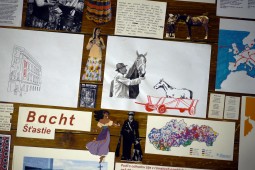On (re)presenting Roma Culture. Three Case Studies
discussion
January 18, 2018 at 5pm
tranzit.sk, Beskydská 12, Bratislava
participants:
Robert Gabriš, Ladislava Gažiová, Oto Hudec, Ondřej Chrobák, Emília Rigová, Anita Topínková
moderator:
Eliška Mazalanová
The discussion will be conducted in Slovak and Czech.
How are Roma presented in artistic institutions and what are the benefits and challenges of the Museum of Romani Culture? What place should be designated for contemporary art in such a museum and what are the tasks that it should perform? What in fact is Roma art and who is a Roma artist? How not to reproduce stereotypes and how to avoid cultural segregation or, on the contrary, cultural colonization?
A number of projects dedicated to the (re)presentation of Roma culture and art have recently and almost simultaneously materialized. Several have tried to provide a more critical reflection of established strategies and stereotypes – for them, creating the narrative by Roma themselves is an important instrument of emancipation. Together with their authors and with the representatives of institutions dealing with Roma culture and as well as visual artists we will talk about Roma (contemporary) art, its institutional representation and about the representation of Roma identity in artistic production.
We will open the discussion with short presentations of the aforementioned projects. A special thematic issue of the magazine Enter dedicated to Roma contemporary art, edited by visual artist, Emília Rigová and Roma studies expert, Nikola Ludlová; its English version was published recently. Its main theme is the critical re-evaluation of the term “Roma art” - the editors focus on the identity of the author and the self-identification of the featured artists with this category. The Universe is Black (O kozmos hino kalo), an exhibition currently running at the Moravian Gallery in Brno, Czech Republic, is the artistic project of Ladislava Gažiová, co-curated by Natália Drtinová and Ondřej Chrobák. It presents the museum exhibition from the collections of Museum of Romani Culture in Brno and re-evaluates “Roma art” from art historical perspective – in particular, by attempting to liberate it from the stereotypical perception as naïve art; on the contrary, it perceives it as an expression of social emancipation with historical and cultural contexts. Finally, the exhibition at tranzit/sk entitled Nadikhuno muzeumos/Invisible Museum was conceived by Oto Hudec, and imagines such museum of Roma culture, lacking in Slovakia, that would offer more than the traditional ethnographic view and would instead focus on contemporary Roma culture, their current social and political situation as well as their history.
Discussion in the framework of Nadikhuno muzeumos exhibition which is a collaboration project between tranzit/sk, Goethe Institut Bratislava and collective Spolka.
ERSTE Foundation is main partner of tranzit.
